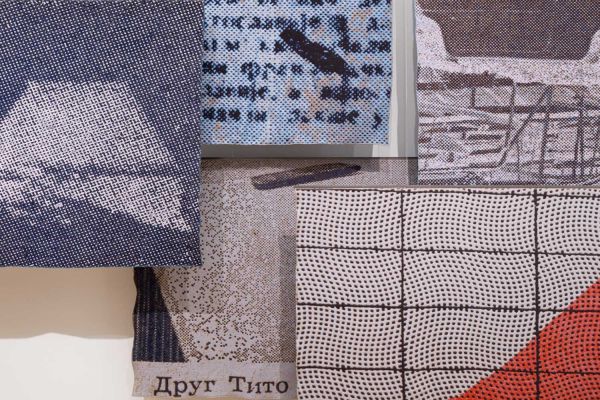Ten woven tapestries, 165 × 247.5cm each, wool and metal, 2014
Reframing the contested issue of Yugoslav history by weaving textiles based on excerpts of history textbooks I make interpretations of past events into palpable material. Study of Focus looks into both tapestry traditions and history textbooks of the former Yugoslavia as parallel yet interrelated phenomena. Both tapestries and history textbooks assume a variety of approaches to illustration, narration, interpretation, and appropriation of historical events.

Since the Socialist Federal Republic of Yugoslavias violent disintegration, national narratives and symbols have become central to each one of the newly formed identities. National symbols are a subtle but integral part of the interiors of governmental and religious buildings, and some are used as the backdrop for commercials and popular culture. The symbols and ornaments of traditional textiles can be traced to Slavic mythology and Orthodox Christianity, and they bear a complicated relationship with Islam dating back to the time of Ottoman rule in the Balkans.
The first effort in categorizing national symbols was published in 1902. In the following years female weavers used Mita Živković catalogue “Album of Pirot Kilims” to give shape to the new symbols and ornaments: “German Boxes,” “Russian Bombs,” and “A Little Soldier” as a way of telling (hi)stories they witnessed.

Similar to the ideological implications of the post-Yugoslavian revival of traditions, history textbooks narrate and illustrate historical events in relation to the ideology of the time. Not only has photography often been regarded as a veracious image, but it has also frequently been treated as a technique in which nature makes an imprint of itself. Being the stencil of reality, photography registers the past, and at the same time, it produces evidence of it.

By looking at the margins of photographic reproductions found in history textbooks from Yugoslavia published from the 1950s to 2002, I made a register of the material changes they embody. I looked into the various approaches to interpreting and illustrating World War II and used the accumulated information to make a laborious textile installation. The study of the physical structure of each page history is printed upon is the focus of the work. Each page reveals a record of different aspects of the time, yet the direction, perspective, and the sequence are no longer recognizable. The inclusion of blotch marks, notes, and lines left by the previous readers reflects my interest in history as a material process. By working with the margins of the page, I emphasize information that cannot be recovered and fed back into the endless flow of information.
